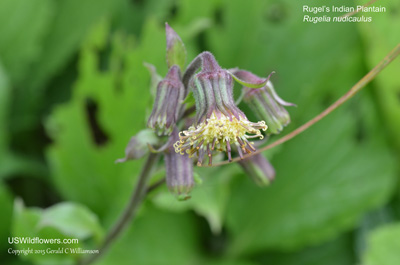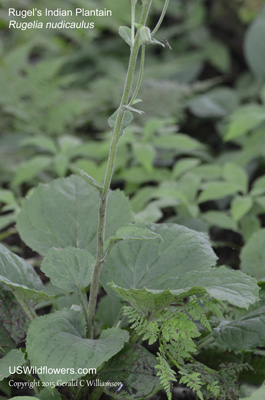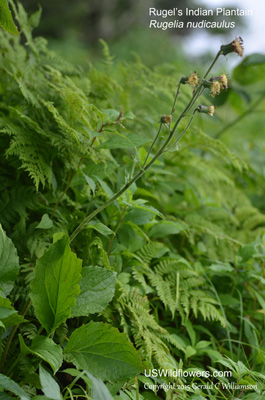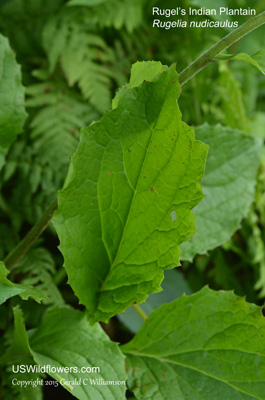Rugelia, Rugel's Indian Plantain, Rugel's Ragwort, Winter Well - Rugelia nudicaulis
|
Rugelia nudicaulis - Rugelia, Rugel's Indian Plantain, Rugel's Ragwort, Winter Well. Rugelia is monotypic - R. nudicaulis is the only species in the genus. This plant was originally classified as Rugelia when it was published in 1860 (collected in 1842), but it was reclassified as Senecio rugelia in 1883 by famous botanist Asa Gray, picking up the Rugel's Ragwort common name. Then in 1974 Theodore M. Barkley and Arthur Cronquist reclassified it as Cacalia rugelia based primarily on the shape of the floral head and the color of the corollas, providing the Rugel's Indian Plantain common name. As near as I can tell, some time between 1974 and his death in 2004 (I think in 1978 while he was overseeing the publication of the Asteraceae family in Flora of North America) Mr. Barkley reclassified the plant back to its original monotypic Rugelia nudicaulis. The plant was named for Ferdinand Ignatius Xavier Rugel, a German-born American botanist.
Rugelia nudicaulus has a very small distribution, being endemic to high altitudes (above 4,000') in Tennessee, where it is listed as Endangered, and North Carolina, where it is listed as Threatened. All known populations are within the Great Smoky Mountains National Park. The photographs on this page were taken along the trail from the parking lot to the observation tower on Clingman's Dome. This is not a showy, beautiful plant, but it is interesting.
Found in:
NC, TN
Leave comments on Rugelia nudicaulis at this link. | 
Distribution of Rugelia nudicaulis in the United States and Canada:

Blue=Native; Grey=Introduced
Map from USDA Plants Database:
USDA, NRCS. 2017. The PLANTS Database (http://plants.usda.gov, 08 May 2025). National Plant Data Team, Greensboro, NC 27401-4901 USA.
Search Our Database: Enter any portion of the Scientific, Common Name, or both.
Do a general Google search of the entire site:
#ad
 Follow USWildflowers on Twitter
#ad
| | Site: GSMNP Clingman's Dome Trail, Swain County, NC Date: 2015-July-16 | Photographer: Gerald C. Williamson
Nikon D7000
Tamron SP 90MM f/2.8 AF Macro | | Rugelia nudicaulus is one of many Asteraceae with only disc florets, there are no ray florets. There are usually 30 to 40 (sometimes as many as 80) disc florets, which are yellowish or creamy white. The blossoms usually nod a little bit, as shown here, from a bend in the pedicel near the flower. The pedicel and calyx are hairy, with the phyllaries usually green with some reddish margins. | | 
| | Site: GSMNP Clingman's Dome Trail, Swain County, NC Date: 2015-July-16 | Photographer: Gerald C Williamson
Nikon D7000 | | The inflorescence of Rugelia nudicaulis is a cyme-like array of several blossoms - the central flower opens first. The reddish margins of the phillaries and the pedicel are quite developed in this plant. | | Click on the photo for a larger image

| | Site: GSMNP Clingman's Dome Trail, Swain County, NC Date: 2015-July-16 | Photographer: Gerald C Williamson
Nikon D7000 | | The stem rises above the toothed basal leaves, and may have a few bract-like leaves alternating on it. It gets more densely hairy toward the top of the plant, but is at least pubescent in the lower part of the stem. The leaves are usually hairy to one extent or another, but in some cases may be nearly glabrous. | | Click on the photo for a larger image

| | Site: GSMNP Clingman's Dome Trail, Swain County, NC Date: 2015-July-16 | Photographer: Gerald C Williamson
Nikon D7000 | | Rugelia nudicaulis grows to between 1 and 2 feet tall. The nudicaulus species epithet is due to the scarcity of stem leaves; most leaves are basal. | | Click on the photo for a larger image

| | Site: GSMNP Clingman's Dome Trail, Swain County, NC Date: 2015-July-16 | Photographer: Gerald C Williamson
Nikon D7000 | | The ovate leaves of Rugelia are primarily basal, and are irregularly toothed. The basal leaves are fairly large, up to 6 inches long; the cauline leaves are significantly smaller. The leaves persist through the winter, giving it the Winter Well common name. | | Click on the photo for a larger image

|
References used for identification and information:
|
|
| |
| #ad
|
|







